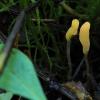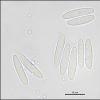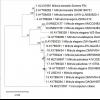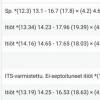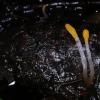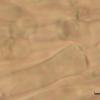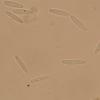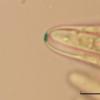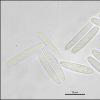
07-01-2026 22:22
 Danny Newman
Danny Newman
Tatraea sp. on indet. hardwood The Swag, Great Sm

07-01-2026 17:29
 Marc Detollenaere
Marc Detollenaere
Dear Forum,On a barkless Populus I found some smal

10-11-2021 17:33
 Riet van Oosten
Riet van Oosten
Add-on topic http://www.ascofrance.com/forum/7059

07-01-2026 10:24
 Danny Newman
Danny Newman
Pezicula sp. on indet. hardwood Appalachian Highl

07-01-2026 10:05
 Danny Newman
Danny Newman
cf. Chaetospermum on XylariaCosby Campground, Grea

02-01-2026 17:43
MARICEL PATINOHi there, although I couldn't see the fruitbody, I

04-01-2026 17:45
 Stephen Martin Mifsud
Stephen Martin Mifsud
I was happy to find these orange asmocyetes which
Spore measurements:
(13.5) 14.6 - 17.6 (18.1) × (2.8) 3.2 - 4 (4.2) µm
Q = (3.4) 3.9 - 5.3 (5.8) ; N = 20
Me = 15.9 × 3.6 µm ; Qe = 4.5
The old paper The genus Mitrula in North America (1977) doesn't seem to clearly key out this specimen. Either this is M. paludosa or M. borealis. The spore measurements would fit M. borealis slightly better, but the spores didn't appear to have a sheath (fresh spore deposit), which might favour M. paludosa.
Any opinions?

Mitrula borealis seems to be very common in SW Finland, perhaps more so than M. paludosa. Some of my observations are recorded here, but I have many more:
https://laji.fi/observation/list?target=mitrula%20borealis
A few weeks ago I collected a Mitrula with spores even broader than borealis according to the Redhead paper. I don't know is it a borealis or still a new one.

About macroscopic differences I am not sure but the working hypothesis is that borealis is more yellow and perhaps bigger. Paludosa might have more brownish tints in the hymenium and pehaps not so elongated hymenial head as borealis.
Likewise, about ecology I have only a working hypothesis: borealis might be more common in spring fed small streams or pools while paludosa is found in any pool or ditch. All acid, virtually no calacreous sites where I collect.
The sequenced one is this:


interesting topic! I must admit I have automatically identified all my Czech collections as M. paludosa. In Czech literature, I haven´t found a mention about M. borealis, but I can see that Redhead mentions occurrence in the neighbouring Germany.
I wonder how often is M. borealis collected in this region...
Yesterday I found Mitrula in the Jeseníky Mts., so I made the first microscopy of it in my life, and it fits better M. paludosa, especially if Redhead worked with dead material. In any case, the are thinner than those in the collections from Finland presented here. Living ascospores measure (13)14.1-18.2(19.2) × (2.8)3-3.6 (3.8) µm, Q = (3.8)4.2-5.6(6.2), n = 40. Me = 15.8 × 3.3 µm; Qe = 4.8. Gelatinous sheath not observed.
Best regards, Zuzana


Spores:
(17.3) 18.1 - 21.3 (22.9) × (2.8) 3 - 3.5 (3.8) µm
Q = (4.6) 5.4 - 6.7 (6.8) ; N = 20
Me = 19.6 × 3.3 µm ; Qe = 6




